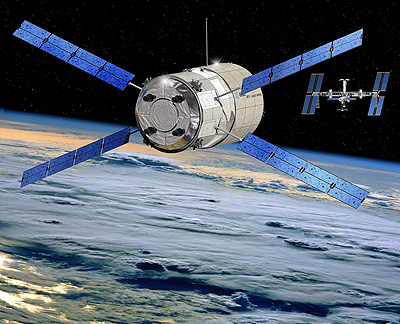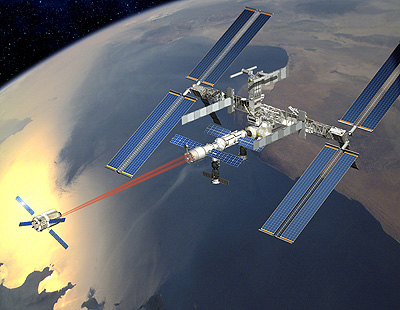Europe's new cargo spacecraft is ready for launch from the European Space Base in French Guinea - the launch is scheduled for March 9

The first Automated Transfer Vehicle (ATV), known as the Jules Verne, is a cargo spacecraft designed to carry large payloads into space. The spacecraft is intended to replace the unmanned Progress spacecraft from the Soviet era, and manned spacecraft such as the Russian Soyuz spacecraft and the American space shuttle fleet.
We will also note that the one-time tasks of the Progress are numbered by the Russians since they do not have much meaning. The Europeans decided to give meaning to each mission and call each ATV model that goes into space by a different name. As mentioned, the name of the first one will be Jules Verne - after the French science fiction writer.
In recent days, the orbit of the space station has been corrected so that when Jules Verne approaches, the astronauts will not be blinded by the sun. Although the entire docking process is automated, the operators decided to leave no room for error. At the end of the docking, the remaining fuel in the module will be used to raise the station back to high orbit.
Europe is entering space with giant strides
The Europeans have invested in the AVT program eleven years of development since 1995, and a total amount of 1.3 billion euros (about 1.96 billion dollars), more than double the amount originally intended for the program. Despite all the problems, the program fits in a central place in the global space race. There is a growing need for cargo services in space, the amount of cargo that goes up to the space station is increasing and their frequency is steadily increasing. The Americans are going to decommission the old space shuttle fleet, and the Russian cargo spacecraft are too small to meet future needs.
The entry of the Europeans into the field of space brought a lot of criticism for the huge sums they were required to invest in the various projects, but today it can be seen that in the foreseeable future they are going to lead in a number of sub-industries in this field. Already today, the Europeans have a sophisticated space center in French Guinea, many satellites go up into space on the Ariane 5 heavy rocket launcher. Now Europe is planning to take a large share of the market also in the field of cargo transport in space. In order to offer added value, at the beginning of the development it was decided to develop a cargo spaceship that would be used as a real "space truck" - a carrying capacity of up to 7.5 tons, while the total weight of the spaceship with the cargo at the time of launch will be 20 tons!

Beyond the advantages already mentioned, the ATV module was specially designed so that its assembly would be fast and flexible according to different specifications and different needs. Its assembly is fast and takes a few months, unlike other models that are produced for the space station and require years of development and assembly. The model is intended to be used once - upload equipment and supplies and after a few weeks/months disconnect together with the garbage and burn in the atmosphere. The size of the module (10 x 4.5 meters) and an internal volume of 48 cubic meters allows a double-decker bus to be inserted into it. The ATV is designed to last in space for several months before it detaches and falls into a garbage can, at the same time, it is possible to assemble more sophisticated models that will serve as permanent additions to the space station - for example, a living room for astronauts or a laboratory.

4 תגובות
The European Union is close in size and economic power to that of the United States of America.
The difference is that the European Union is divided into dozens of countries, each country has an average of 5 different peoples (in Spain: Basques, Castilians, Austrians, and more; in England, Welsh, Franks, Britons, Scots, Irish, and more, not to mention even more divided countries like Belgium and the Planted Hand)
America's research and development budget in the US is 8 times (!!!) higher than the European one.
And we'll move on to China: when was the last time you saw a Chinese movie? Book ? series ? a show?
The Chinese are in the convergence phase which is characteristic of many dictatorial powers similar to the USSR which demonstrated great power in the 60's and 70's. This phase is characterized by the utilization of resources (work force) to achieve a narrow goal (foreign currency and industry) but like any dictatorship that prevents freedom from thought, discoveries Breakthrough science cannot appear in it. In 20 years, China will be fatally affected by the aging of its population (due to the birth restriction). It is very fashionable to say that China is the next superpower. But it is not.
As someone who has traveled extensively in China I can assure you commenter 1 that 95% of the population consists of rural people without regular electricity and water supply.
The Japanese bloc has a chance to become a superpower in the next 50-100 years
Europe and the Indian subcontinent have a chance to become superpowers in the next 100-150 years (currently India is also divided into approximately 300 nations)
The former Soviet bloc has a chance to become a superpower in the next 200 years.
In any case, in my uneducated estimation, in the next 100 years we will not see a worthy contender for the USA. Europe is very far behind. Very.
America Vs Europe:
A space truck that runs on fossil fuel? Navigation systems? The Europeans are doing today what the USA did in the sixties, with zero computing power.
One can only imagine what the real gap is between the US and the rest of the world (and just think of stealth technology, for example).
You speak against the country where MIT, Bell Labs, IBM and dozens if not hundreds of research and development institutes that have no equal in the world operate. All this alongside the strongest economy and military in the world and a quality of life that everyone aspires to (more or less).
Personally, it seems to me that America directs its R&D budgets in more effective directions. Today there is no competition for the academic and technological power of the USA. (Maybe China, in the future?).
We'll see…
Tell me, is it imaginary to say that America is approaching the day when it will no longer be independent in anything?